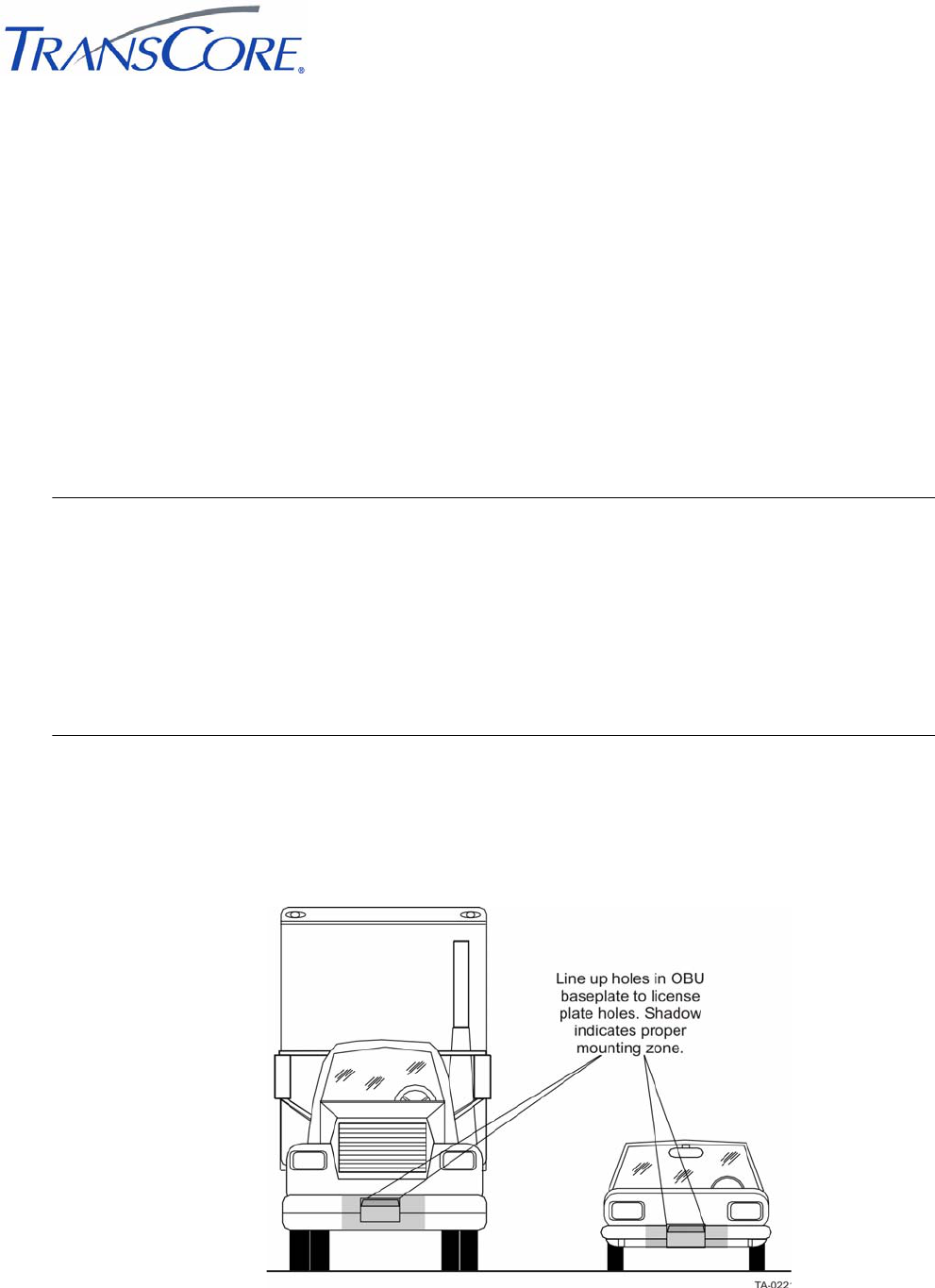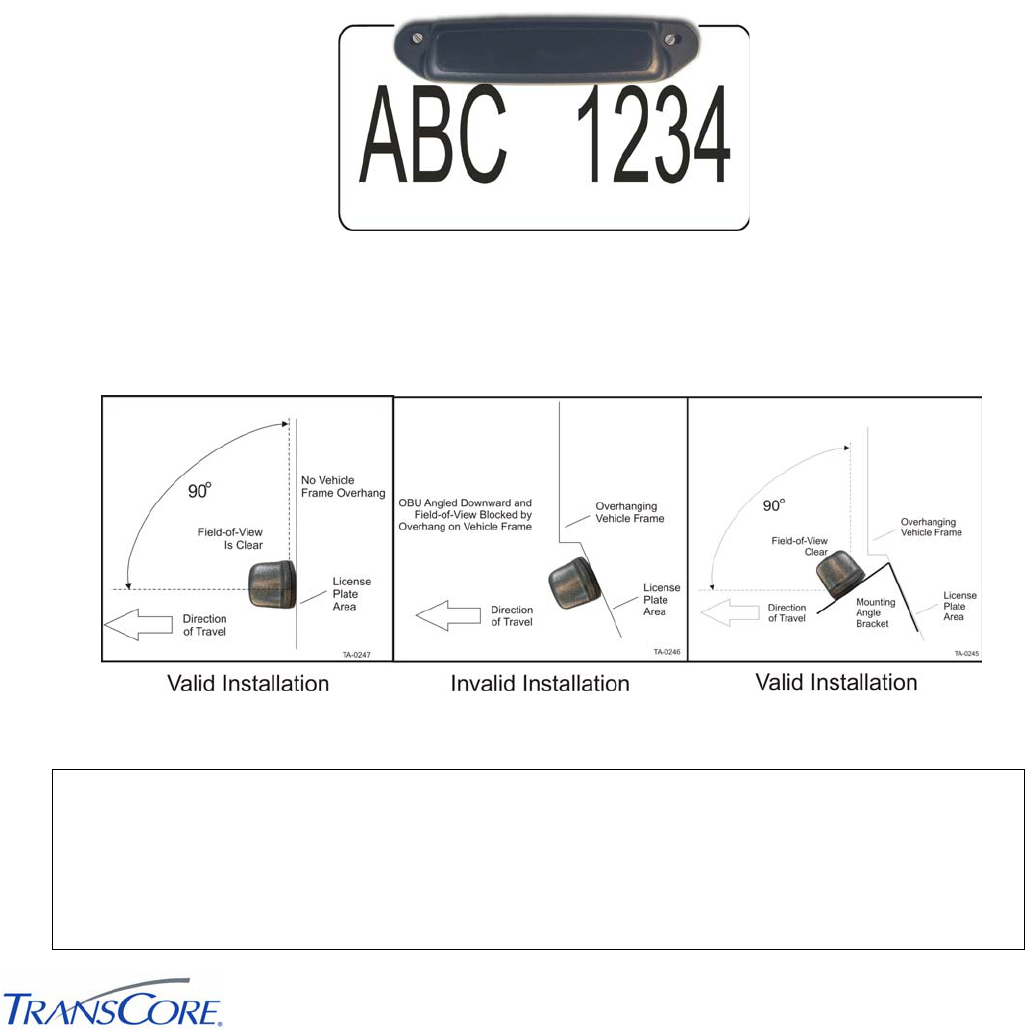TransCore 05751 LOW POWER TRANSMITTER (915 MHz) User Manual 600039 003 Exterior OBU Instructions
TransCore LOW POWER TRANSMITTER (915 MHz) 600039 003 Exterior OBU Instructions
Users Manual

This document describes the procedures to install the Exterior On-Board Unit (OBU) on the outside of a commercial or
passenger vehicle.
The typical mounting location for an Exterior OBU is over the license plate at the upper part of a vehicle’s front license plate
area (Figure 1).
Note: If your state does not require a front license plate, install the Exterior OBU in the area where the license plate would
normally be mounted. If your vehicle does not have a designated front license plate mounting area, contact your tag agency for
other options.
Supplies
•Exterior OBU (may have double-sided tape for secure mount)
•Screwdriver (flat-blade or Phillips depending on your vehicle’s license plate mounting screws)
•Optional two self-tapping threaded screws (customer supplied)
•Optional TransCore Exterior Tag Accessory Kit (19077-01). This kit contains tamper-resistant mounting screws and
wrench.
Exterior OBU Installation Procedures
To mount the Exterior OBU in the license plate area
1. Remove the screws from the license plate area of your front bumper (Figure 1). If your vehicle does not have mounting
screws you will need two self-tapping threaded screws. You can also contact the tag agency to inquire about the optional
TransCore Exterior Tag Accessory Kit.
Note: You may need to use longer screws to fasten the OBU over the top area of your license plate.
Figure 1 Typical Mounting Location for Exterior OBU
Exterior On-Board Unit Installation
600039-003 08/11

www.transcore.com
© 2010 TC License, Ltd. All rights reserved. TRANSCORE is a registered trademark of TC License, Ltd. All other trademarks listed are the property of their respective owners.
Contents are subject to change. Printed in the U.S.A.
SPECIFICATIONS
600039-003 08/11
2. Position the OBU so that it is within 18 inches (46 cm) of the center of the front bumper as shown by the shaded area
in Figure 1. If your vehicle’s license plate mounting area is more than 18 inches (46 cm) from the center, you may need
to select an alternate location on the bumper to mount the OBU. Contact your tag agency if your vehicle requires an
alternate mounting location for the OBU.
3. Hold the OBU so that the mounting holes are to the top and fasten the OBU to the bumper using the license plate
mounting screws (Figure 2). Install the OBU over the top area of the vehicle’s license plate if your vehicle has a front
license plate. If your state does not require a front license plate, install the OBU in the area where a license plate would
normally be mounted.
Figure 2 Placement Over the Upper Area of the License Plate
The license plate should have a 90-degree field-of-view to the overhead antenna as the vehicle approaches the toll
plaza/gantry. If the vehicle bumper limits the field-of-view or if the license plate area is angled downward toward
the pavement, you can use an angled mounting bracket to point the OBU upward to increase the field of view and
improve performance (Figure 3).
Figure 3 Examples of OBU Installations
NO UNAUTHORIZED MODIFICATIONS STATEMENT
Caution: This equipment may not be modified, altered, or changed in any way without permission from TransCore, LP. Unauthorized modification may void the equipment
authorization from the FCC and will void the TransCore warranty.
RADIO FREQUENCY INTERFERENCE STATEMENTS
Note: This device complies with Part 15 of the FCC Rules and the Industry Canada Licence-Exempt RSS Standards. Operation is subject to the following two conditions: (1)
this device may not cause interference, and (2) this device must accept any interference, including interference that may cause undesired operation of this device.
Note: Le présent appareil est conforme aux CNR d’Industrie Canada applicables aux appareils radio exempts de licence. L’exploitation est autorisée aux deux conditions
suivantes: (1) l’appareil ne doit pas produire de brouillage, et (2) l’utilisateur del’appareil doit accepter tout brouillage radioélectrique subi, même si le brouillage est
susceptible d’en compromettre le fonctionnement.